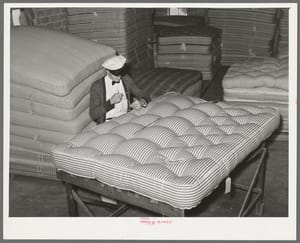How you might make a mattress: Get a bunch of natural fiber. Cotton, wool, hemp, and straw; horsehair or horsetail, if you’re fancy. Lay it out in layers on the floor or a big table, making sure to put the mattress’s bottom cover down first. Put the densest layer on the bottom and lighter ones on top, or maybe make a big sandwich with the dense stuff in the middle so the mattress can be flipped. Make your side panels out of fabric; maybe these have little vents sewn into them, and maybe they have handles, and maybe they’re quilted so they look nice and provide a little structure. Wrap the side panels around your sandwich, then use a long needle to stitch through the sides at a forty-five degree angle, exiting through the top of the sandwich. At this point maybe you add some loose fill on top – your wool, perhaps, or cotton felt or feathers or loosely matted horsehair. Then put your top cover on; then tick and sew the corners; then compress the entire mattress and tuft it in a grid pattern so the layers don’t shift around.
Maybe this mattress is too traditional; you want foam. Latex foam: Your latex is tapped from a Brazilian rubber tree, but of course it’s a Thai or Indonesian Brazilian rubber tree, because history; regardless, the latex is filtered, sulfurated and vulcanized in a heated mold and now it’s squishy and yet stable, in the “not gonna get oozy when summer comes” sense of the word. Or memory foam: Your memory foam is mostly polyurethane, which is to say that it’s made from fossil fuels; if you really want to shave the yak then you can go and find some fossil fuels, and you can heat them up and pull off a fraction here and a fraction there and eventually end up with some isocyanates and some polyols and when they react with one another they’ll create a pair of monomers and let’s call that a sufficient description of polyurethane production, don’t you think? Now you’ve got your foam. You basically sew a cover on it — maybe print your logo on the cover, probably suck all the air out of the foam and vacuum-bag it because it’s open cell and a smaller box is cheaper to store and cheaper to ship and anyway there’s a certain type of customer — your target customer — who is endeared by the idea of a mattress that starts its life with them as one of those sponge dinosaurs that you put in water to make it grow not preposterously large per se but certainly much larger than it started out.
This mattress feels a little contrived. You decide you don’t want a mattress at all – you want a futon. It’s similar to the first one but more foldy: Layer upon layer of cotton, the layers being tapered on the edges and then turned back onto themselves with nicely mitered corners. The whole thing is tucked into a flat sack (no sides on your futon’s case; it’s a pillow, not a cushion). The corners are tasseled, the body is tufted, the futon is folded in thirds like a “z.” You kneel down on the floor next to it, proud of your work, and take a bow.
SOURCES/SCOPE CREEP.
Read the full story
The rest of this post is for paid members only. Sign up now to read the full post — and all of Scope of Work’s other paid posts.
Sign up now

